|

|
Click here for photos of our
apartment, Kunming page
two (including photos of the International
Horticultural Expo and the Minorities park), and Kunming page one.
Kunming has a long, proud history. The
area was particularly important during World War 2 (called the War of
Resistance Against Japan or War Against
Japanese Aggression here in China). This marker is close to the back gate of our
apartment complex in Kunming, and it commemorates the work done by both Chinese and
foreign workers to build the Burma Road (called the Dian Mian Highway in
Chinese)--China's supply lifeline in the
early 1940s. This is the spot where the road began.
See my YNNU page to read about how
that university got started when China's major universities set up
temporary residence here during the war. |
 |
 |
|

Of course,
Kunming has changed a lot since World War 2! In fact, it has changed a lot
in the five years we've lived here (2005-2010). The photo above shows a
little piece of this huge city, with somewhere near 7 million residents,
taken from the roof of our apartment building.
|
|
In early 2010,
Vivian's office moved to the "tall" building in the center of the above
photo (to the right of the tall building in the foreground). The photo
below is taken from the office (again, note the tall building near the
middle--our apartment is just behind it).
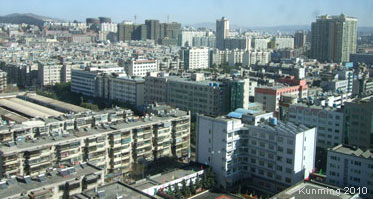
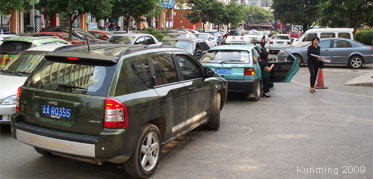 |
The
worst thing about Kunming's changes - in my humble opinion - is the
increasingly terrible traffic conditions. Hundreds of cars are added to
the roads daily, but most of the city grew when private cars were illegal
(there were few before 2000). Now (2010), Kunming has one of the highest
per capital rates of private car ownership in China. Parking in my
apartment complex is a nightmare (below left)! Roads are regularly jammed.
The trip from Kunming to the satellite city of
Chenggong takes an hour on a good day, but I've been stuck in traffic
for three hours on the same route. But, to be fair, I thought you'd like
to read a more positive view from one of my students:
Recent Improvements in Kunming’s Traffic Conditions
In the past five years, Kunming has improved its crowed traffic condition
by extending the city boundaries and building new roads. Firstly,
Kunming's boundaries now include the satellite city of
Chenggong, where a new city hall, a university
town, shopping malls, a hospital and residential districts have been built
one after another. Nearly 100,000 people have moved in; therefore, the
population density in the old downtown area has decreased. Moreover, new
roads and seventeen overpasses encircling the city have been constructed,
like a huge net connecting downtown with the suburbs. Driving at the
maximum speed - 60 kilometers per
hour - on the new roads has become a joyful experience. People can save
more than one hour in reaching some destinations. The enlarged city and
newly constructed highways have helped make the transportation in Kunming
faster and more convenient. -- by Sharry (KMU graduate student, December
2009) |
|
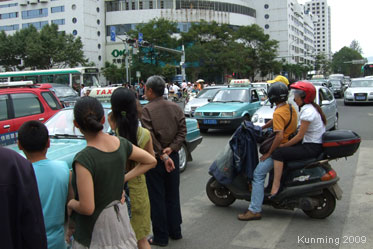
Traffic on
Renmin Rd in front of part of the Medical University's #1 Affiliated
Hospital (near the old campus) |
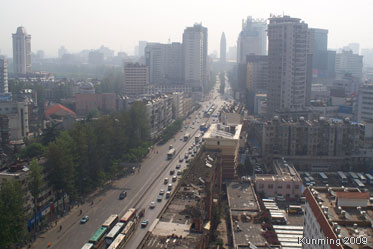
This cityscape
was taken from one of the hospital's buildings, on an uncharacteristically
hazy day (the sky is normally blue). |
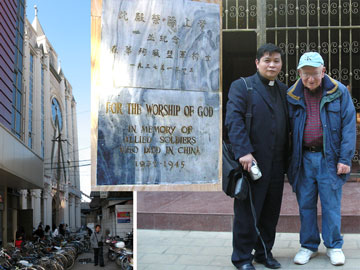 |
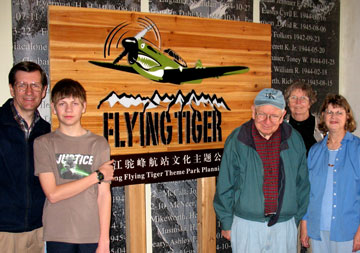 |
|
(Above left) St. John's chrch is located in the heart of the shopping
district. The current building (the third on this site, I believe) was
completed in 2006, but the inset shows an interesting historical marker
everyone sees as they enter ("In memory of Allied soldiers who died in
China, 1939-1945"). As I showed this to my father, the pastor
came out, and when he heard that my dad knew someone who served in China with
the Flying Tigers he asked to have a photo taken together. We were moved
by the love and respect that this leader showed for the Americans who
helped China fight Japan in World War 2. Since then, I (Michael) have
enjoyed lively Thursday night services with this man and hundreds of
enthusiastic Chinese believers.
(Above right and below) A friend of ours here in Kunming was part of a
group working to set up a Flying Tigers theme park in
Li-jiang. The Flying
Tigers were a highly successful group of American volunteers who fought
against tremendous odds to stop Japan from bombing cities in south China, and to
protect the Burma Road. Both my parents and friends from Scotland (below)
were impressed by the vision and plans for this interesting museum and
tribute to American-Chinese cooperation. Unfortunately, the group had to
give up on the park, being unable to get enough sponsors. Maybe someday...
Visit http://flyingtigersavg.com to see some cool paintings of the
Flying Tigers.[broken
link?] |
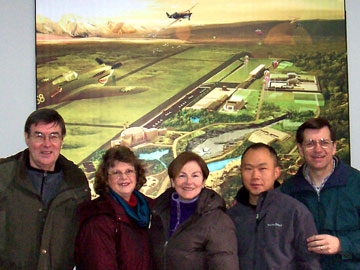 |
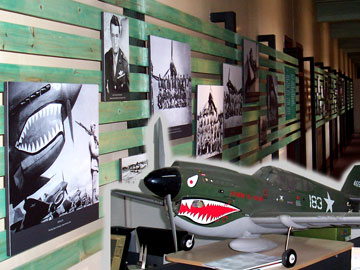 |

Click in the boxes below to go to some of our most popular pages. If
you get lost, just click "Home."
See our
Policy
regarding the use of materials available at Krigline.com or
Krigline.com.cn
|










